remote start SAAB 9-3 2000 Owners Manual
[x] Cancel search | Manufacturer: SAAB, Model Year: 2000, Model line: 9-3, Model: SAAB 9-3 2000Pages: 236, PDF Size: 10.85 MB
Page 30 of 236
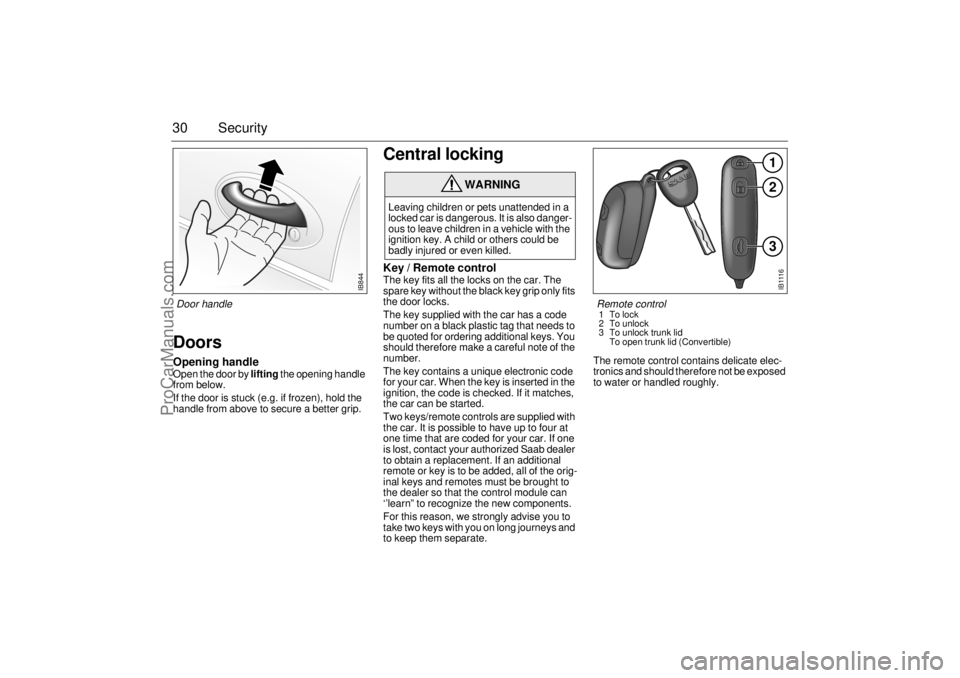
30 SecurityDoorsOpening handleOpen the door by lifting the opening handle
from below.
If the door is stuck (e.g. if frozen), hold the
handle from above to secure a better grip.
Central locking Key / Remote control The key fits all the locks on the car. The
spare key without the black key grip only fits
the door locks.
The key supplied with the car has a code
number on a black plastic tag that needs to
be quoted for ordering additional keys. You
should therefore make a careful note of the
number.
The key contains a unique electronic code
for your car. When the key is inserted in the
ignition, the code is checked. If it matches,
the car can be started.
Two keys/remote controls are supplied with
the car. It is possible to have up to four at
one time that are coded for your car. If one
is lost, contact your authorized Saab dealer
to obtain a replacement. If an additional
remote or key is to be added, all of the orig-
inal keys and remotes must be brought to
the dealer so that the control module can
‘’learn” to recognize the new components.
For this reason, we strongly advise you to
take two keys with you on long journeys and
to keep them separate.The remote control contains delicate elec-
tronics and should therefore not be exposed
to water or handled roughly.
WARNING
Leaving children or pets unattended in a
locked car is dangerous. It is also danger-
ous to leave children in a vehicle with the
ignition key. A child or others could be
badly injured or even killed.
IB844
Door handle
I B 111 6
123
Remote control 1To lock
2 To unlock
3 To unlock trunk lid
To open trunk lid (Convertible)
ProCarManuals.com
Page 31 of 236
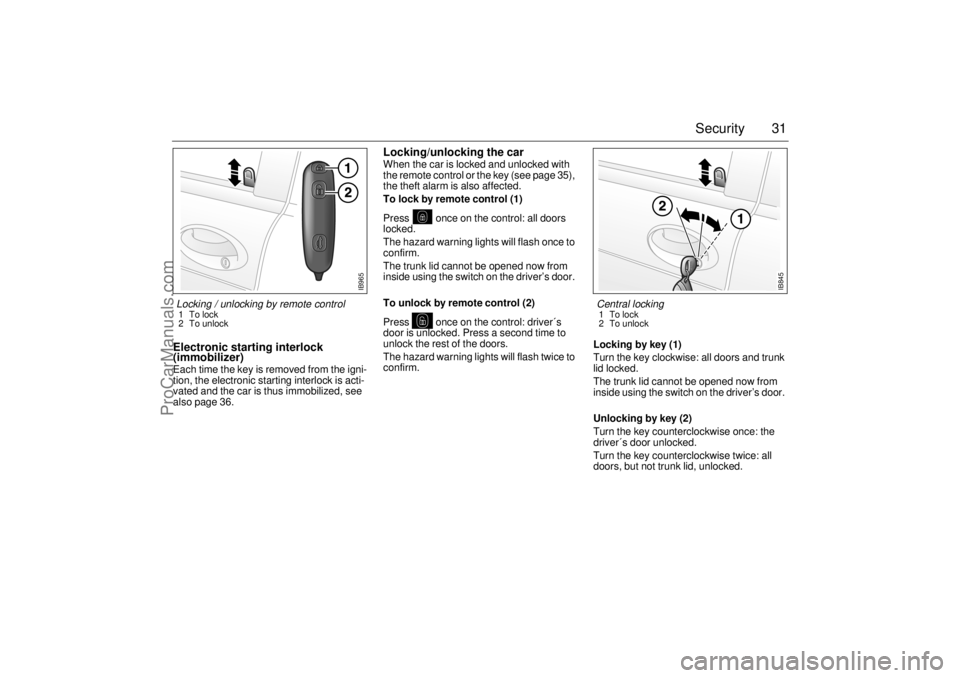
31 Security
Electronic starting interlock
(immobilizer)Each time the key is removed from the igni-
tion, the electronic starting interlock is acti-
vated and the car is thus immobilized, see
also page 36.
Locking/unlocking the carWhen the car is locked and unlocked with
the remote control or the key (see page 35),
the theft alarm is also affected.
To lock by remote control (1)
Press once on the control: all doors
locked.
The hazard warning lights will flash once to
confirm.
The trunk lid cannot be opened now from
inside using the switch on the driver’s door.
To unlock by remote control (2)
Press once on the control: driver´s
door is unlocked. Press a second time to
unlock the rest of the doors.
The hazard warning lights will flash twice to
confirm. Locking by key (1)
Turn the key clockwise: all doors and trunk
lid locked.
The trunk lid cannot be opened now from
inside using the switch on the driver’s door.
Unlocking by key (2)
Turn the key counterclockwise once: the
driver´s door unlocked.
Turn the key counterclockwise twice: all
doors, but not trunk lid, unlocked.
IB845
Central locking 1To lock
2 To unlock
IB965
Locking / unlocking by remote control 1To lock
2 To unlock
ProCarManuals.com
Page 35 of 236
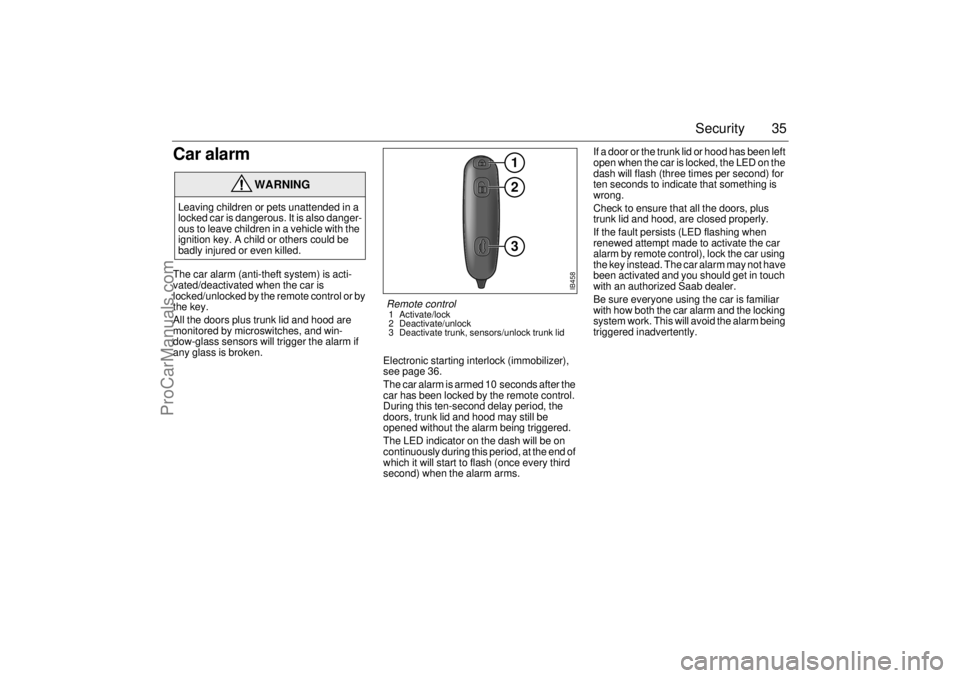
35 Security
Car alarmThe car alarm (anti-theft system) is acti-
vated/deactivated when the car is
locked/unlocked by the remote control or by
the key.
All the doors plus trunk lid and hood are
monitored by microswitches, and win-
dow-glass sensors will trigger the alarm if
any glass is broken.
Electronic starting interlock (immobilizer),
see page 36.
The car alarm is armed 10 seconds after the
car has been locked by the remote control.
During this ten-second delay period, the
doors, trunk lid and hood may still be
opened without the alarm being triggered.
The LED indicator on the dash will be on
continuously during this period, at the end of
which it will start to flash (once every third
second) when the alarm arms. If a door or the trunk lid or hood has been left
open when the car is locked, the LED on the
dash will flash (three times per second) for
ten seconds to indicate that something is
wrong.
Check to ensure that all the doors, plus
trunk lid and hood, are closed properly.
If the fault persists (LED flashing when
renewed attempt made to activate the car
alarm by remote control), lock the car using
the key instead. The car alarm may not have
been activated and you should get in touch
with an authorized Saab dealer.
Be sure everyone using the car is familiar
with how both the car alarm and the locking
system work. This will avoid the alarm being
triggered inadvertently.
WARNING
Leaving children or pets unattended in a
locked car is dangerous. It is also danger-
ous to leave children in a vehicle with the
ignition key. A child or others could be
badly injured or even killed.
IB458
123
Remote control 1 Activate/lock
2 Deactivate/unlock
3 Deactivate trunk, sensors/unlock trunk lid
ProCarManuals.com
Page 36 of 236

36 SecurityActivating the car alarmThe car alarm (anti-theft system) is
activated/deactivated when the car is
locked/unlocked by the remote control or by
the key.
The car alarm cannot be activated if the
driver’s door is open or if the ignition switch
is in position ON.
If, on the other hand, one of the other doors
or the trunk or hood is open or opened and
not closed again during the 10-seconds
delay period, it will be excluded from the
alarm function.
If it is then closed, a new delay period of ten
seconds will start, and the door (or trunk or
hood) will once again be secured by the
alarm system.
As usual, the LED will be on continuously
during the new delay period and will start to
flash every three seconds after the 10-sec-
onds period has elapsed.
Window glass sensorThe car-alarm (anti-theft system) incorpo-
rates a sensor that monitors the window
glass for the sound of breakage. The sensor
is fitted inside the rear dome light (on Con-
vertibles: in the front interior light).
To avoid false alarms, such as the alarm
being triggered by children or pets left inside
the car, the sensor can be temporarily dis-
abled.
To disable the sensor
To disable the sensor, first turn off the igni-
tion and remove the key from the switch.
Next, press and hold the NIGHT PANEL
button until ”DOOR ALARM ONLY” appears
on the SID and a chime sounds. The car
alarm must now be activated within three
minutes, or the glass sensor will become
active again.
The glass sensor will be enabled again
automatically the next time the car is
unlocked. The sensor can also be enabled
again by repeating the procedure for dis-
abling it. When the sensor has been
enabled, ”FULL THEFT ALARM” will
appear on the SID.
If a fault is detected in the glass sensor,
”SERVICE THEFT ALARM” will appear on
the SID.
9-3 Convertible: when the car is parked
with the soft top down, the glass sensor will
be automatically disabled.
Electronic starting interlock
(immobilizer)When the key is inserted in the ignition, a
signal is sent to the receiver. If the signal is
verified, the engine can be started.
Each time the key is removed from the igni-
tion, the electronic immobilizer is activated.
If a fault is detected (e.g. in the transmitter)
”KEY NOT ACCEPTED” will appear on the
SID.
In this case, you can still start the car if you
turn the ignition key to ON and press one of
the buttons on the remote control.
Take the car to an authorized Saab dealer to
have the system checked.
The LED on the top of the dash dou-
ble-flashes when the car is immobilized.
ProCarManuals.com
Page 39 of 236

39 Security
Overview of, LED signals and SID messagesSome signals may differ between model variants for different
countries.Status LED signal
Activation (during 10-second delay). Comes on for 10 seconds.
Alarm activated (after delay). Flashes once every third
second.
Deactivation. Comes on for 2 seconds.
Alarm not activated. Off.
Door, trunk lid or hood open or
opened during delay period.Flashes three times per sec-
ond for 10 seconds.
Unlocking the trunk lid. Flashes three times per sec-
ond for 10 seconds.
Closing of door, trunk lid or hood
after delay period.Comes on for 10 seconds.
Car immobilized but not locked.
Car alarm not activated.Flashes twice at three sec-
onds intervals.
Fault in a switch serving doors, hood
or trunk lid.Flashing (instead of being
on continuously) during
delay period.
SID message Reason/action
SERVICE THEFT ALARM Probably a faulty sensor or siren.
Have the car checked by an autho-
rized Saab dealer.
KEY NOT ACCEPTED Fault in key transmitter or in igni-
tion-switch receiver. Turn ignition
switch to ON and press one of the
buttons on the remote control. Start
the engine.
Have the car checked by an autho-
rized Saab dealer.
REPLACE KEY BATTERY Fit a new battery in the remote con-
trol.
DOOR ALARM ONLY Window-glass sensor is disabled.
FULL THEFT ALARM Window-glass sensor is included in
circuit.
REMOTE KEY
TRANSPONDRTurn the ignition key to position ON
and then press the button for open-
ing the trunk lid. SID displays the
number of remote controls and
transmitters (transponders) coded to
the car.
ProCarManuals.com
Page 135 of 236
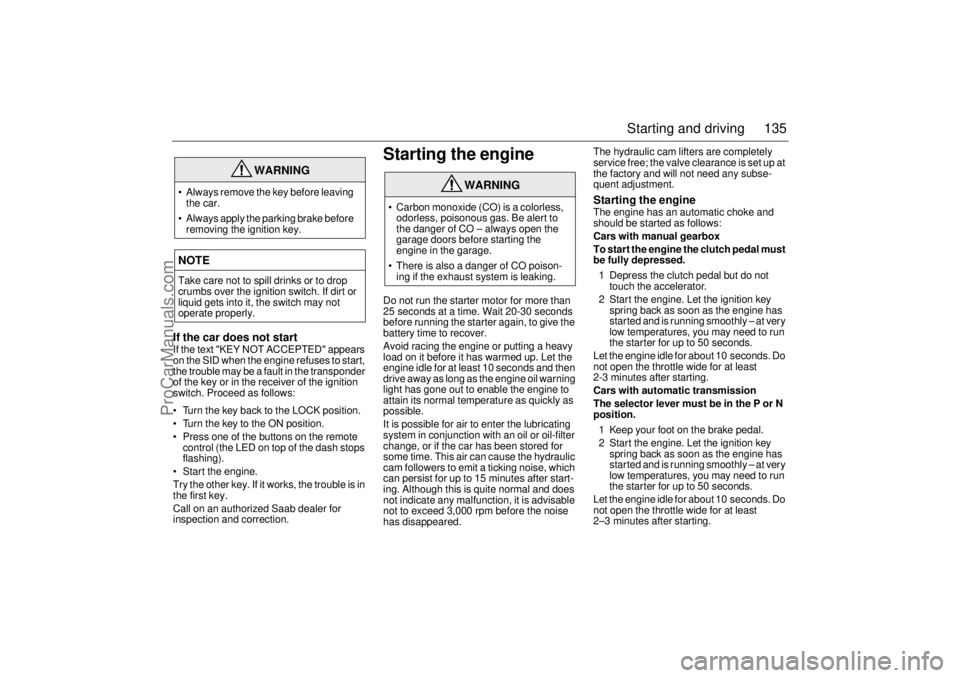
135 Starting and driving
If the car does not startIf the text "KEY NOT ACCEPTED" appears
on the SID when the engine refuses to start,
the trouble may be a fault in the transponder
of the key or in the receiver of the ignition
switch. Proceed as follows:
• Turn the key back to the LOCK position.
Turn the key to the ON position.
Press one of the buttons on the remote
control (the LED on top of the dash stops
flashing).
Start the engine.
Try the other key. If it works, the trouble is in
the first key.
Call on an authorized Saab dealer for
inspection and correction.
Starting the engineDo not run the starter motor for more than
25 seconds at a time. Wait 20-30 seconds
before running the starter again, to give the
battery time to recover.
Avoid racing the engine or putting a heavy
load on it before it has warmed up. Let the
engine idle for at least 10 seconds and then
drive away as long as the engine oil warning
light has gone out to enable the engine to
attain its normal temperature as quickly as
possible.
It is possible for air to enter the lubricating
system in conjunction with an oil or oil-filter
change, or if the car has been stored for
some time. This air can cause the hydraulic
cam followers to emit a ticking noise, which
can persist for up to 15 minutes after start-
ing. Although this is quite normal and does
not indicate any malfunction, it is advisable
not to exceed 3,000 rpm before the noise
has disappeared. The hydraulic cam lifters are completely
service free; the valve clearance is set up at
the factory and will not need any subse-
quent adjustment.
Starting the engine The engine has an automatic choke and
should be started as follows:
Cars with manual gearbox
To start the engine the clutch pedal must
be fully depressed.
1 Depress the clutch pedal but do not
touch the accelerator.
2 Start the engine. Let the ignition key
spring back as soon as the engine has
started and is running smoothly – at very
low temperatures, you may need to run
the starter for up to 50 seconds.
Let the engine idle for about 10 seconds. Do
not open the throttle wide for at least
2-3 minutes after starting.
Cars with automatic transmission
The selector lever must be in the P or N
position.
1 Keep your foot on the brake pedal.
2 Start the engine. Let the ignition key
spring back as soon as the engine has
started and is running smoothly – at very
low temperatures, you may need to run
the starter for up to 50 seconds.
Let the engine idle for about 10 seconds. Do
not open the throttle wide for at least
2–3 minutes after starting.
WARNING
Always remove the key before leaving
the car.
Always apply the parking brake before
removing the ignition key.NOTETake care not to spill drinks or to drop
crumbs over the ignition switch. If dirt or
liquid gets into it, the switch may not
operate properly.
WARNING
Carbon monoxide (CO) is a colorless,
odorless, poisonous gas. Be alert to
the danger of CO – always open the
garage doors before starting the
engine in the garage.
There is also a danger of CO poison-
ing if the exhaust system is leaking.
ProCarManuals.com
Page 154 of 236

154 Starting and driving Driving in a low gear results in higher fuel
consumption than in a high gear because
of the lower engine speed for a given road
speed. Always change up to a higher gear
as soon as traffic conditions allow and use
the highest gear as much as possible.
Check the air pressure in the tires once a
month. Incorrect pressures increase tire
wear. It is better to have slightly higher
pressure than lower.
Check fuel consumption regularly.
Increased consumption can indicate that
something is wrong and that the car
needs to be checked by an authorized
Saab dealer.
Practical tests on the roads have demon-
strated that substantial savings in fuel con-
sumption can be made if the above advice
is heeded.Road conditions Wet roads increase fuel consumption, as do
unpaved roads and driving in hilly country
(the amount of fuel saved driving downhill is
less than the additional amount required to
climb the hill).
Engine block heater (standard
equipment in Canada, accessory in
U.S.)The following are just some of the benefits
to the car and the environment of using an
engine block heater:
Lower fuel consumption.
Reduced wear on the engine.
Inside of car warms up faster.
Exhaust emissions substantially reduced
over short runs.
The engine block heater is effective with
outside temperatures up to +60 – +70°F
(+15 – +20°C). The warmer it is outside, the
shorter the time the heater need be con-
nected. Longer than 1.5 hours is unneces-
sary.
If the car is equipped with a removable elec-
trical cabin heater that is not in use, this
should be stored in the luggage compart-
ment.
Driving in cold weatherBefore starting a journey in cold weather
you should check the following:
That the wiper blades have not become
frozen to the windshield/glass.
Brush any snow away from the air intake
for the heater system (opening between
hood and windshield).
It may be advisable to lubricate the
door-lock cylinder (use molybdenum
disulphide, MoS
2) to prevent its freezing.
If the lock has frozen, take care not to
break the key (or use the remote control)
– heat it first or spray it with de-icer.
Periodically during the winter, add gaso-
line anti-freeze to the fuel to dispel any
condensation in the fuel tank which could
freeze and cause problems in the system.
Keep the tank well filled to reduce the risk
of condensation forming.
If the car is parked outside in freezing
weather, fuel additives (gasoline
anti-freeze) will not do any good as it
cannot remove water that has already fro-
zen. Park the car in a warm place so that
any ice that may have built up melts, then
add gasoline anti-freeze when filling up
the tank. Condensation is caused by
changes in the outdoor temperature or by
the car being parked alternately in a
garage and outside.
It is particularly important when the roads
are slippery that the brakes and tires be in
good condition.
ProCarManuals.com
Page 164 of 236

164 Starting and driving
5 Check that the jumper cables do not
have loose or missing insulation. If they
do, you could get a shock and also the
vehicles could be damaged.
Before you connect the cables, here are
some basic things you should know.
Positive (+) will go to positive (+) and
negative (-) will go to negative (-) or a
major metal engine part with a good
ground. Do not connect (+) to (-) or you
will get a short that could injure you or
would damage the battery and maybe
other parts as well.
6 Connect the red positive (+) cable to the
positive (+) terminal of the vehicle with
the discharged battery.
7 Do not let the other end touch metal.
Connect it to the positive (+) terminal of
the good battery. Use a remote positive
(+) terminal if the vehicle has one.
8 Now connect the black negative (-)
cable to the good battery’s negative ter-
minal.
Do not let the other end touch anything
until the next step. The other end of the
negative cable does not go to the dead
battery. It goes to a major metal part with
a good ground on the engine of the vehi-
cle with the discharged battery.9 Attach the cable at least 18 inches
(45 cm) away from the discharged bat-
tery, but not near engine parts that
move. The electrical connection is just
as good there, but the chance of sparks
getting back to the battery is much less.
10 Start the vehicle with the good battery
and run the engine for a while.
11 Try to start the vehicle with the dis-
charged battery. If it does not start after
a few tries, it probably needs service.
12 Remove the cables in reverse order to
prevent electrical shorting. Take care
that they do not touch each other or any
other metal.
WARNING
Using a match or flame of any kind near a
battery can cause battery gas to explode.
You can suffer burns or be blinded. Use a
flashlight if you need more light.
Be sure the battery has enough water.
The battery installed in your new Saab
has filler caps. Be sure the right amount
of water is there. Add distilled or boiled
water if the level is too low. If you don’t,
explosive gas could be present.
Be sure the electrolyte in the battery is not
frozen. Discharged batteries will freeze.
When connecting jumper cables to a
frozen battery, gas from the chemical
reaction inside the battery can build up
under the ice and cause an explosion.
Battery fluid contains acid that can burn
you. Do not get it on you. If you acciden-
tally get it in your eyes or on your skin,
flush the area with water and get medical
help immediately.
ProCarManuals.com
Page 165 of 236
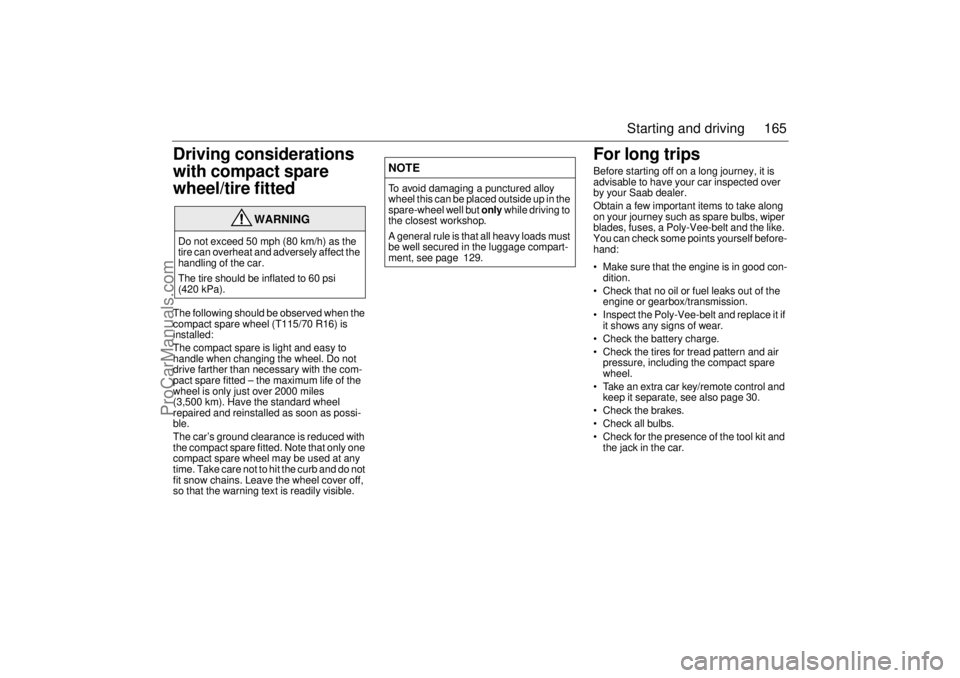
165 Starting and driving
Driving considerations
with compact spare
wheel/tire fitted The following should be observed when the
compact spare wheel (T115/70 R16) is
installed:
The compact spare is light and easy to
handle when changing the wheel. Do not
drive farther than necessary with the com-
pact spare fitted – the maximum life of the
wheel is only just over 2000 miles
(3,500 km). Have the standard wheel
repaired and reinstalled as soon as possi-
ble.
The car’s ground clearance is reduced with
the compact spare fitted. Note that only one
compact spare wheel may be used at any
time. Take care not to hit the curb and do not
fit snow chains. Leave the wheel cover off,
so that the warning text is readily visible.
For long tripsBefore starting off on a long journey, it is
advisable to have your car inspected over
by your Saab dealer.
Obtain a few important items to take along
on your journey such as spare bulbs, wiper
blades, fuses, a Poly-Vee-belt and the like.
You can check some points yourself before-
hand:
Make sure that the engine is in good con-
dition.
Check that no oil or fuel leaks out of the
engine or gearbox/transmission.
Inspect the Poly-Vee-belt and replace it if
it shows any signs of wear.
Check the battery charge.
Check the tires for tread pattern and air
pressure, including the compact spare
wheel.
Take an extra car key/remote control and
keep it separate, see also page 30.
Check the brakes.
Check all bulbs.
Check for the presence of the tool kit and
the jack in the car.
WARNING
Do not exceed 50 mph (80 km/h) as the
tire can overheat and adversely affect the
handling of the car.
The tire should be inflated to 60 psi
(420 kPa).
NOTETo avoid damaging a punctured alloy
wheel this can be placed outside up in the
spare-wheel well but only while driving to
the closest workshop.
A general rule is that all heavy loads must
be well secured in the luggage compart-
ment, see page 129.
ProCarManuals.com
Page 235 of 236

235 Index
Manual climate-control system
______ 76
Manual raising of the soft top,
Convertible
____________________ 46
Manually opening the fuel filler door,
Convertible ____________________ 52
Manually opening the fuel filler door,
Coupé and 5-door
______________ 131
Maxi fuses
_____________________ 188
Memory, driver’s seat
____________ 117
Motoring abroad
________________ 165
NNight Panel
_____________________ 69
OOdometer
______________________ 59
Oil specification
_________________ 223
OnStar
_______________________ 109
Opening handle
_________________ 30
Owner assistance _______________ 213
PPaint touch-up
__________________ 202
Parcel shelf
____________________ 128
Parking
_______________________ 151
Parking brake
__________________ 151Parking lights
___________________ 71
Plates and labels ________________ 229
Power-steering fluid, check
________ 177
Pressure gauge
__________________ 60
Programmable driver’s seat
_______ 117
Programming, ACC
_______________ 86
RRadio
__________________________ 94
Raising the soft top, Convertible
_____ 45
Rear fog light
____________________ 73
Rear seat
_____________________ 125
Rear seat, tipping
_______________ 125
Rear window wiper _______________ 75
Rearview mirrors
________________ 124
Rear-window wiper _______________ 75
Recirculation
____________________ 78
Recycling
_____________________ 205
Refuelling _____________________ 138
Relay table ____________________ 190
Remote control __________________ 30
Remote control battery, changing
____ 32
Reporting safety defects
__________ 214
Rev counter
_____________________ 59
Reversing lights
_________________ 73
Rotating the tires ________________ 193
Running-in
_____________________ 140
SSAHR, head restraint
____________ 114
SID (Side instrument display)
_______ 62
SRS (airbag)
____________________ 22
Safety belts
_____________________ 12
Safety belts, care of
______________ 199
Seat-belt pretensioners
____________ 13
Seats
_________________________ 112
Securing a load
__________________ 33
Service costs
___________________ 213
Service information
______________ 214
Service intervals
________________ 212
Service record retention
__________ 213
Side airbag
_____________________ 27
Side airbags ____________________ 27
Ski hatch
______________________ 128
Snow tires _____________________ 227
Soft-top storage, Convertible
________ 50
Spare wheel
___________________ 130
Speedometer ____________________ 59
Starting the engine
______________ 135
Steering pump oil, grade
__________ 226
Steering-wheel adjustment ________ 118
Sunroof
_______________________ 120
TTachometer
_____________________ 59
Tailgate, opening
_________________ 33
Technical data
__________________ 220
ProCarManuals.com